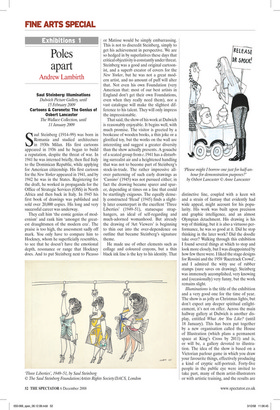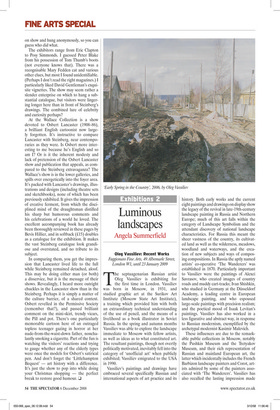Poles apart
Andrew Lambirth
Saul Steinberg: Illuminations Dulwich Picture Gallery, until 15 February 2009 Cartoons & Coronets: The Genius of Osbert Lancaster The Wallace Collection, until 11 January 2009 Saul Steinberg (1914–99) was born in Romania and studied architecture in 1930s Milan. His first cartoons appeared in 1936 and he began to build a reputation, despite the threat of war. In 1941 he was interned briefly, then fled Italy to the Dominican Republic, while applying for American citizenship. His first cartoon for the New Yorker appeared in 1941, and by 1942 he was in the States. Registering for the draft, he worked in propaganda for the Office of Strategic Services (OSS) in North Africa and then back in Italy. In 1945 his first book of drawings was published and sold over 20,000 copies. His long and very successful career was underway.
They call him ‘the comic genius of modernism’ and rank him ‘amongst the greatest draughtsmen of the modern era’. The praise is too high, the assessment sadly off mark. You only have to compare him to Hockney, whom he superficially resembles, to see that he doesn’t have the emotional depth, resonance or range that Hockney does. And to put Steinberg next to Picasso or Matisse would be simply embarrassing. This is not to discredit Steinberg, simply to get his achievement in perspective. We are so hedged in by superlatives these days that critical objectivity is constantly under threat. Steinberg was a good and original cartoonist, and a superb creator of covers for the New Yorker, but he was not a great modern artist, and no amount of puff will alter that. Not even his own Foundation (very American that: most of our best artists in England don’t get their own Foundations, even when they really need them), nor a vast catalogue will make the slightest difference to his talent. They will only impress the impressionable.
That said, the show of his work at Dulwich is reasonably enjoyable. It begins well, with much promise. The visitor is greeted by a bookcase of wooden books, a thin joke or a glorified toy, but the works on the wall are interesting and suggest a greater diversity than the show actually presents. A gouache of a seated group from c.1941 has a disturbing surrealist air and a heightened handling that was not to become part of Steinberg’s stock-in-trade. The rather impressive allover patterning of such early drawings as ‘Cassino’ (1945) was not pursued either; in fact the drawing became sparer and sparer, depending at times on a line that could be startlingly exiguous. The equally densely constructed ‘Head’ (1945) finds a slightly later counterpart in the excellent ‘Three Liberties’ (1949–51), statuesque straphangers, an ideal of self-regarding and much-adorned womanhood. But already the drawing of ‘Art Viewers’ is beginning to thin out into the over-dependence on outline that became Steinberg’s signature theme.
He made use of other elements such as collage and coloured crayons, but a thin black ink line is the key to his identity. That distinctive line, coupled with a keen wit and a strain of fantasy that evidently had wide appeal, might account for his popularity. His work was built upon precision and graphic intelligence, and an almost Olympian detachment. His drawing is his way of thinking, but it is also a virtuoso performance, he was so good at it. Did he stop thinking in the later work? Did the doodle take over? Walking through this exhibition I found several things at which to stop and look more closely, but I was disappointed by how few there were. I liked the stage designs for Rossini and the 1958 ‘Racetrack Crowd’, and I admired the witty use of rubber stamps (sure saves on drawing). Steinberg was immensely accomplished, very knowing and (occasionally) very funny, but the work remains slight.
Illuminations is the title of the exhibition and a very good one for the time of year. The show is as jolly as Christmas lights, but don’t expect any deeper spiritual enlightenment, it’s not on offer. Across the main hallway gallery at Dulwich is another display, entitled What Are You Like? (until 18 January). This has been put together by a new organisation called the House of Illustration (which plans a permanent space at King’s Cross by 2011) and is, or will be, a gallery devoted to illustration. The idea of the show is based on a Victorian parlour game in which you draw your favourite things, effectively producing a kind of cryptic self-portrait. Forty-five people in the public eye were invited to take part, many of them artist-illustrators or with artistic training, and the results are on show and hung anonymously, so you can guess who did what.
The exhibitors range from Eric Clapton to Posy Simmonds. I guessed Peter Blake from his possession of Tom Thumb’s boots (not everyone knows that). There was a recognisable Mary Fedden cat and various other clues, but most I found unidentifiable. (Perhaps I don’t read the right magazines.) I particularly liked David Gentleman’s exquisite vignettes. The show may seem rather a slender enterprise on which to hang a substantial catalogue, but visitors were lingering longer here than in front of Steinberg’s drawings. The combined lure of celebrity and curiosity perhaps?
At the Wallace Collection is a show devoted to Osbert Lancaster (1908–86), a brilliant English cartoonist now largely forgotten. It’s instructive to compare Lancaster with Steinberg, near contemporaries as they were. Is Osbert more interesting to me because he’s English and so am I? Or is it the inherent modesty and lack of pretension of the Osbert Lancaster show and publication that appeals, as compared to the Steinberg extravaganza? The Wallace’s show is in the lower galleries, and spills over energetically into the foyer area. It’s packed with Lancaster’s drawings, illustrations and designs (including theatre sets and sketchbooks), none of which has been previously exhibited. It gives the impression of creative ferment, from which the disciplined mind of the draughtsman distilled his sharp but humorous comments and his celebrations of a world he loved. The excellent accompanying book has already been thoroughly reviewed in these pages by Bevis Hillier, and in softback (£15) doubles as a catalogue for the exhibition. It makes the vast Steinberg catalogue look grandiose and overstated, and no tribute to its subject.
In comparing them, you get the impression that Lancaster lived life to the full while Steinberg remained detached, aloof. This may be doing either man (or both) a disservice, but it is the message of their shows. Revealingly, I heard more outright chuckles in the Lancaster show than in the Steinberg. Perhaps it is simply a matter of the culture barrier, of a shared context. Osbert revelled in the Permissive Society (remember that?), and passed brilliant comment on the mini-skirt, trendy vicars, the Pill and pot. There’s one particularly memorable cartoon here of an outraged topless teenager gazing in horror at her nude-from-the-waist-down father, nonchalantly smoking a cigarette. Part of the fun is watching the visitors’ reactions and trying to gauge whether any of the elderly types were once the models for Osbert’s satirical pen. And don’t forget the ‘Littlehampton Bequest’ — art history with a difference. It’s just the show to pop into while doing your Christmas shopping — the perfect break to restore good humour. ❑



















































































 Previous page
Previous page